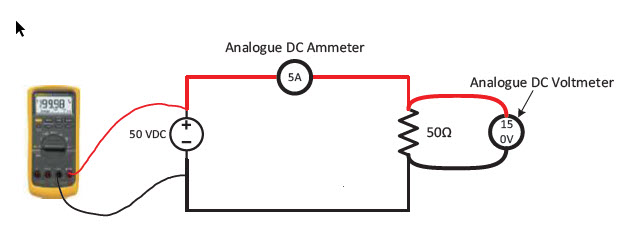54 Activities
Calculating Electrical Terms
- The statement which correctly represents Ohm’s law:
a. V = IR
b. V = R/I
c. R = VI
d. I = R/V - A 10-ohms resistor is powered by a 5-V battery. The current flowing through the source is:
a. 10 A
b. 50 A
c. 2 A
d. 0.5 A - If V = 50 V and I = 5 A, then R = ?
a. 50 Ω
b. 5 Ω
c. 10 Ω
d. 2 Ω - If P = 50 watt and R = 2 ohms, then I = ?
a. 50 A
b. 5 A
c. 10 A
d. 2 A - Unit of voltage is:
a. Volt
b. Watt
c. Coulomb
d. Ampere - Unit of current is:
a. Volt
b. Watt
c. Coulomb
d. Ampere - Unit of power is:
a. Volt
b. Watt
c. Coulomb
d. Ampere - Unit of resistance is:
a. Volt
b. Watt
c. Ohms
d. Ampere - If I = 5 A and R = 10 Ω, then P = ?
a. 50 watts
b. 250 watts
c. 350 watts
d. 500 watts
Watt’s Law (Power) problems:
- P = 10 watts, I = 2 amperes, then E = __________ V
- E = 100 volts, I = 0.5 amps, then P = __________ W
- P = 500 watts, E = 250 V, then I = __________ A
Answers
- V = IR
- 2 A
Solution: From I = V/R = 5-V/10 ohm = 0.5 A - 10 Ω
Solution: From R = V/I = 50 V/ 5A = 10 Ω - 5 A
Solution: From I = √(P/R) = √(50 V/ 2A) = √25 A = 5 A - Volt
- Ampere
- Watt
- Ohms
- 250 watt
Solution: Here P = I2R = (5 A)2 * 10 Ω = 250 watts - 5V
Solution: Here 10W/2A = 5V - 50W
Solution: Here 100V × .5A = 50W - 2A
Solution: Here 500W/250V = 2A
Practical Competency “Use Multi Meters”
Never measure Resistance and use the Ohmeter function on a live circuit.
Objective
To complete this Practical Competency you will be expected to use a Various Analogue meters, a Digital Multimeter (DMM) and a Clamp-on Ammeter. Meters are used daily in the field for safety testing and troubleshooting purposes. Using them correctly and safely is vital. The purposes of this Practical Competency are:
- To safely use various meters to measure Voltage, Current and Resistance
- To correctly use different types of meters (Analog and Digital)
- To demonstrate the affect of increasing resistance in an electrical circuit
Safety
- Students must have steel toe boots, appropriate clothing, and safety glasses for use in the labs
- Students must perform a Hazard assessment of the work area.
- Never use the Ohmmeter function on a live circuit
- If you are unsure about using a Meter or piece of equipment, consult the user manual.
Equipment and materials
- Elworthy Bench (Electrical Bay #1)
- Digital Multimeter and Clamp-on Ammeter (Tool Crib)
- Assortment of Test Leads (Tool Crib)
Using Ohm’s and Watt’s Law, calculate the expected circuit values and record in Table 1
*Only measure resistance when circuit is de-energized!
- Calculate values first.
- Obtain the material listed above, from the Tool crib and choose an Elworthy bench that is not in use.
- Measure the 50, 100 and 150 Ω Resistors to confirm their values and ensure that they are functioning and record your measurements in Table 2 before connecting in the circuit below.
- Connect the Circuit shown below, using the variable DC power supply and starting with the 50 Ω Resistor. Connect the analogue meters supplied on the Elworthy bench, in to the circuit.

- Have your instructor check your circuit before energizing
- Energize the circuit and adjust the voltage to 50 Volts on the dial. Measure and record the current and voltage values of the meters in Table 2. Turn on digital meter and set to DC Volts. Using the digital meter across the source.
- De-energize the circuit and replace the 50 Ω resistor with the 100 Ω resistor. Measure and record your current and voltage readings in Table 1.
- De-energize the circuit and replace the 100 Ω resistor with the 150 Ω resistor. Measure and record your current and voltage readings in Table 2.
Observations
Table 1: Calculated Values
| Voltage | Current | Measured Wattage | |
|---|---|---|---|
| Resistor #1 = 50 Ω | I=E/R | P=EXI | |
| Resistor #2 = 100 Ω | 50V |
Table 2: Analogue Meters
| Voltage | Current | Measured Resistance* | |
|---|---|---|---|
| Resistor #1 = 50 Ω | |||
| Resistor #2 = 100 Ω | |||
| Resistor #3 = 150 Ω |
*Only measure resistance when circuit is de-energized
Questions
- Why is it important to measure the resistors before connecting them to the circuit?
- What happened to the current in the circuit when the resistance value doubled from 50 Ohms to 150 Ohms? Why?
- What happens to the current value as the resistance is decreased? Why?
- What happens to the Wattage as the Current decreases? Why?

At Home Practical Competencies
How Much Does It Cost to Charge a Tesla?
Tesla has been around since 2003, but now that electric cars are becoming more common, they’re also becoming more affordable. As gas prices are going up, the cost to charge electric vehicles is going down. Take a look at this example which explains how much it costs to charge a Tesla Model 3 at a home charging station:
- The battery capacity is 75kW, and our current average electricity rate that we’re going to use is 13 cents per kWh
- This means that your charging cost is equal to 75 × $0.13 = $9.75 for a complete “fill up” that will get you around for approximately 240 miles.
- Compare charging the Teslato filling up a smaller car that has a 12-gallon gas tank. When we use a gasoline cost of $3.85 per gallon, it’s pretty clear that the $46.20 you spend on filling up your car with gas (12 × $3.85 = $46.20) is way more expensive than using the Tesla charging station. It may get you 300-400 miles of drive time, but even charging the Tesla twice is less than half the cost of one tank of gas.
How Do I Calculate the Consumption of an Electrical Appliance?
How Do I Estimate What My Electricity Bill Will Be?
Let’s use the national average rate of around 13 cents per kWh to calculate how much it costs to power a 100-watt light bulb every hour. Since it takes 100 watts of power to work — to convert the power in watts to kilowatt-hours — you will multiply 100 watts by one hour. Then, you’ll divide by 1,000 to find the energy usage in kWh.
- Energy = (100 × 1) ÷ 1,000 Energy = 100 ÷ 1,000
- Energy = 0.1 kWh Hourly cost = electricity cost per kWh ÷ energy use in kWh
- Hourly cost = $0.13 ÷ 0.1 kWh Hourly cost = 1.3 cents
- If electricity costs 13 cents per kWh, then a 100-watt light bulb will cost 1.3 cents for every hour that it’s on. Most electric bills are calculated monthly.
To estimate your monthly costs, you can follow these steps:
Estimate how many hours per day you use that light bulb on average. (Let’s say it’s 5 hours). Multiply the light bulb’s watts by the average number of hours you use it daily instead of the one hour used in the formula above. (Let’s say your light bulb is 60 watts, so that you would calculate 60 watts × 5 hours).
Solve the equation above using your light bulb’s actual wattage and the actual average number of hours you use that light bulb per day.
(60 × 5 = 300 ÷ 1,000 = 0.3 kWh)
Divide your area’s average electricity cost by your light bulb’s average daily kWh. ($0.13 ÷ 0.3 kWh =43 cents per day.
Multiply your answer by 30 to get the monthly average kWh for that light bulb. In this case, $0.43 × 30 days = $3.90. It would cost you $3.90 per month to leave a 60-watt light bulb on for an average of 5 hours per day, every day.
Repeat this equation for all light bulbs, appliances, and other electrical devices in your home.
Add up the total to find your estimated monthly electricity costs in kilowatt-hours. You may be surprised to see how fast it all adds up.

